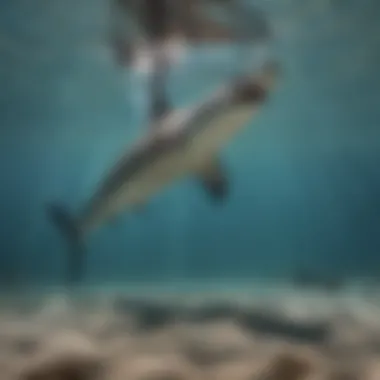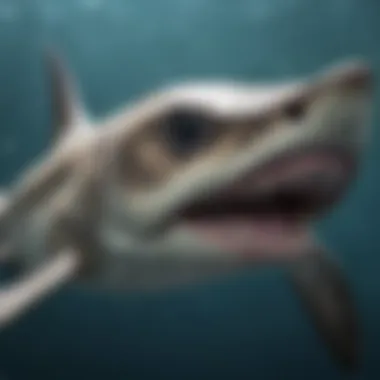Unveiling the Enigmatic Discoveries of Hammerhead Shark Research


Nature Topic Overview
In the intricate world of hammerhead shark research, there lies a vast reservoir of secrets waiting to be unveiled. These enigmatic beings of the deep have captivated scientists and marine enthusiasts alike with their unique features and mysterious behaviors. From the remarkable structure of their heads to the intricacies of their social interactions, hammerhead sharks continue to intrigue and astonish researchers worldwide.
Fun Facts and Trivia
Delving into the realm of hammerhead shark research reveals a treasure trove of fascinating facts sure to spark curiosity in young minds. Did you know that hammerheads possess a highly developed sense of electroreception, enabling them to detect prey hidden beneath the ocean floor? Their distinctive heads, known as cephalofoils, provide an enhanced sensory system, making them incredibly efficient hunters in the vast expanse of the ocean. Additionally, these marine marvels are known for their communal behavior, often forming schools during migration, adding to the mystique surrounding their social dynamics.
Wildlife Explorations
Exploring the world of hammerhead sharks opens up a gateway to understanding not only this captivating species but also the diverse array of marine life that inhabits their ecosystem. From other shark species coexisting in the same waters to the symbiotic relationships shared with various fish and invertebrates, the interconnectedness of marine biodiversity comes to light. An exploration of their habitat reveals the critical role hammerheads play in maintaining the delicate balance of the oceanic food chain, emphasizing the importance of preserving their environment for the well-being of all marine life.
Environmental Awareness
The conservation of hammerhead sharks and their natural habitat is paramount in safeguarding these majestic creatures for future generations. Given their vulnerability to overfishing and habitat destruction, raising awareness about the need for sustainable practices is crucial. Educating children on the significance of marine conservation instills a sense of responsibility towards protecting these awe-inspiring animals and the oceans they call home. Simple actions, such as reducing plastic consumption and supporting marine sanctuaries, can make a tangible difference in ensuring the long-term survival of hammerhead sharks and their fellow inhabitants of the sea.
DIY Nature Activities
For young nature enthusiasts eager to engage in hands-on learning, there are numerous DIY activities inspired by the world of hammerhead shark research. Dive into the depths of creativity by crafting your own shark-themed artwork or conducting experiments to understand the science behind shark adaptations. Outdoor explorations offer a firsthand experience of marine ecosystems, allowing children to witness the wonders of nature up close while fostering a sense of awe and respect for the environment. By immersing themselves in these interactive and educational endeavors, children can cultivate a deep appreciation for the marvels of the natural world and the importance of conservation efforts.
Introduction to Hammerhead Sharks
Diving deep into the world of hammerhead sharks is a fascinating journey filled with intriguing discoveries. These unique marine predators have captured the attention of researchers and enthusiasts alike due to their distinctive anatomy and captivating behavioral patterns. In this article, we will explore the evolutionary history and physical characteristics of hammerhead sharks, shedding light on their adaptations over time and the insights gleaned from fossil records.
Evolutionary History
Adaptations over Time:
The evolutionary journey of hammerhead sharks is a testament to their remarkable adaptations over time. These creatures have honed specific characteristics that have enabled them to thrive in diverse oceanic environments. One key aspect of their adaptations is their unique head structure, which plays a crucial role in enhancing their sensory capabilities and maneuverability in the water. This adaptation has been instrumental in their predatory success and survival in the ever-changing marine ecosystem.
Fossil Records Insights:
Delving into the fossil records of hammerhead sharks provides valuable insights into their evolutionary trajectory. By examining ancient remains, scientists have uncovered essential clues about the species' development and evolutionary milestones. The fossil records offer a glimpse into the past environments these sharks inhabited, shedding light on their growth patterns and ecological interactions. This information is vital for understanding the historical context of hammerhead shark evolution and its implications for current research.


Physical Characteristics
Distinctive Head Structure:
The distinctive head structure of hammerhead sharks is a defining feature that sets them apart from other marine species. Their hammer-shaped heads, known as cephalofoils, serve a range of functions, including increased sensory perception and improved hunting efficiency. This unique adaptation allows hammerheads to detect prey more effectively and navigate their surroundings with precision, giving them a competitive edge in their marine habitat.
Sensory Organs Exploration:
Exploring the sensory organs of hammerhead sharks reveals a fascinating array of adaptations that contribute to their sensory prowess. From electroreception to lateral line systems, these sharks boast a sophisticated sensory toolkit that aids them in detecting prey, navigating ocean currents, and communicating with other members of their species. Studying these sensory organs provides valuable insights into the sensory ecology of hammerhead sharks and enhances our understanding of their behavior and survival strategies.
Behavioral Patterns and Habitat
In this comprehensive expedition into understanding the mysteries of hammerhead shark research, exploring their behavioral patterns and habitat holds paramount importance. By dissecting the intricate behaviors and environmental preferences of these fascinating creatures, researchers can gain valuable insights that unlock the enigma surrounding their existence. Delving into the depths of their feeding habits, mating behavior, and migration patterns offers a holistic view of how hammerhead sharks navigate and thrive in their marine habitats.
Feeding Habits
Prey Preferences
Prey preferences play a pivotal role in the survival and ecological dynamics of hammerhead sharks. These sharks exhibit a distinct affinity for certain prey species due to their nutritional value and availability in their habitats. Understanding the key characteristics of their prey preferences sheds light on the intricate web of predator-prey relationships within the marine ecosystem. The unique feature of specialized prey preferences contributes to the efficient foraging behavior of hammerhead sharks, ensuring their sustenance in the vast oceanic realm.
Hunting Strategies
The hunting strategies employed by hammerhead sharks are finely tuned mechanisms honed through evolution to maximize their hunting success. Their methodical approach to hunting involves utilizing their keen senses and distinctive head structure to locate and capture prey effectively. By highlighting the strategic advantages of their hunting techniques, this article illuminates the adaptive prowess of hammerhead sharks in navigating the challenges of securing food in their marine environment.
Mating Behavior
Courtship Rituals
Courtship rituals among hammerhead sharks encompass a series of elaborate displays and behaviors that facilitate mate selection and courtship bonding. The key characteristic of these courtship rituals lies in the intricate choreography of movements and signals exchanged between potential mates. This unique feature enhances the reproductive success of hammerhead sharks by ensuring compatible mating partners and promoting genetic diversity within their populations.
Reproductive Biology
The reproductive biology of hammerhead sharks encapsulates the intricate processes involved in fertilization, gestation, and offspring development. The key characteristic of their reproductive biology lies in the adaptability of their reproductive strategies to environmental cues and resource availability. Understanding the unique features of hammerhead shark reproductive biology provides valuable insights into population dynamics and sustainability in the ever-changing marine ecosystem.


Migration Patterns
Global Movements
The global movements of hammerhead sharks reveal a complex network of migratory pathways and critical habitats essential for their survival. The key characteristic of these global movements underscores the remarkable navigational abilities of hammerhead sharks in traversing vast distances across oceanic regions. By elucidating the unique features of their migratory behavior, this article unravels the seasonal patterns and connectivity vital for safeguarding the migratory routes of these majestic marine travelers.
Environmental Influences
Environmental influences shape the migratory patterns and distribution of hammerhead sharks, highlighting the intricate interplay between biological imperatives and external factors. The key characteristic of environmental influences on hammerhead shark migration underscores the adaptability and resilience of these predators in responding to changing environmental conditions. By examining the unique features of environmental impacts on migration, this article underscores the importance of conservation efforts in mitigating anthropogenic threats and preserving the natural habitats critical for the sustenance of hammerhead shark populations.
Research Techniques and Discoveries
Tracking Methods
Satellite Tagging
Delving into Satellite Tagging within hammerhead shark research unveils its indispensable role in tracking the movements and behaviors of these marine predators. The distinctiveness of Satellite Tagging lies in its ability to offer real-time data on the sharks' locations, aiding researchers in mapping their migratory patterns with precision. This method emerges as a valuable choice for this article due to its non-invasive nature and high accuracy in data collection. While Satellite Tagging offers unparalleled insights into shark behavior, its drawback includes high costs associated with equipment and satellite communication.
Acoustic Monitoring
Discussing Acoustic Monitoring sheds light on its significant contribution to understanding hammerhead sharks' acoustic communication and behavior. The key essence of Acoustic Monitoring lies in its capacity to capture underwater sounds emitted by the sharks, providing vital information on their social interactions and habitat preferences. This method proves beneficial for this article due to its efficiency in studying shark vocalizations and communication patterns. Despite its advantages, Acoustic Monitoring may be limited by factors such as background noise interference and signal range constraints.
Biomedical Insights
Physiological Studies
Exploring Physiological Studies within the realm of hammerhead shark research uncovers essential details about their internal functions and adaptations. The critical characteristic of Physiological Studies lies in its ability to examine the sharks' physiological responses to varying environmental conditions, aiding in understanding their resilience and survival strategies. This method stands out as a popular choice for this article due to its in-depth insights into shark metabolism and bodily processes. However, conducting Physiological Studies may pose challenges related to sample collection and laboratory analysis.
Health Assessment
Delving into Health Assessment offers invaluable information on the overall well-being and health status of hammerhead sharks. The key aspect of Health Assessment revolves around evaluating the sharks' physical condition, identifying any potential diseases or external impacts. This method proves beneficial for this article by highlighting the importance of shark health in ecological conservation efforts. Despite its merits, Health Assessment may face limitations in capturing comprehensive health data due to environmental factors and shark behavior.
Ecological Impact Assessment


Role in Ecosystem
Examining the Role in Ecosystem emphasizes the significance of hammerhead sharks in maintaining ecological balance within marine habitats. The pivotal characteristic of Role in Ecosystem lies in the sharks' position as apex predators, regulating prey populations and marine ecosystem dynamics. This aspect proves beneficial for this article by elucidating the crucial role hammerhead sharks play in preserving marine biodiversity. However, managing the conservation of sharks as keystone species can present challenges related to human activities and environmental changes.
Conservation Implications
Discussing Conservation Implications delves into the repercussions of human actions on hammerhead shark populations and their habitats. The prominent feature of Conservation Implications lies in highlighting the urgent need for conservation measures to protect these vulnerable species from extinction. This facet proves essential for this article by accentuating the pressing need for sustainable practices and community involvement in shark conservation efforts. Despite its importance, implementing effective conservation strategies may encounter obstacles stemming from economic factors and societal attitudes.
Challenges and Future Prospects
In the realm of hammerhead shark research, the section focusing on Challenges and Future Prospects plays a vital role in shedding light on the impending issues and opportunities within this field. Understanding the challenges faced by these marine creatures provides critical insights into the conservation efforts required to ensure their survival. Moreover, delving into the future prospects allows researchers to develop innovative strategies for effectively studying and safeguarding hammerhead sharks in their natural habitats.
Human Interaction
Fisheries Impact
When discussing the specific aspect of Fisheries Impact within the context of hammerhead shark research, it becomes evident that human activities such as overfishing and bycatch significantly affect hammerhead populations. The relentless pursuit of hammerhead sharks for commercial purposes poses a threat to their existence and disrupts the balance of marine ecosystems. Recognizing the key characteristic of Fisheries Impact underscores the urgency of implementing sustainable fishing practices and regulations to mitigate the adverse effects on hammerhead shark populations. Despite its deleterious consequences, Fisheries Impact serves as a poignant reminder of the need for comprehensive conservation strategies to protect these vulnerable species.
Habitat Degradation
In the discourse surrounding Habitat Degradation in relation to hammerhead sharks, the degradation of essential marine habitats emerges as a pressing concern. The destruction of critical habitats such as coral reefs and coastal areas directly impacts the availability of prey and breeding grounds for hammerhead sharks. By elucidating the key characteristic of Habitat Degradation, researchers emphasize the urgent need to address habitat loss through ecosystem restoration and protection measures. Recognizing the unique feature of Habitat Degradation underscores the interconnectedness of marine ecosystems and highlights the importance of preserving hammerhead shark habitats for sustainable biodiversity.
Technological Advancements
Innovative Research Tools
Exploring the realm of Innovative Research Tools unveils groundbreaking technologies that revolutionize hammerhead shark research methodologies. The incorporation of satellite tagging and advanced tracking systems offers researchers unprecedented insights into the movement patterns and behaviors of these elusive creatures. Highlighting the key characteristic of Innovative Research Tools underscores their pivotal role in expanding our knowledge of hammerhead sharks and enhancing conservation efforts. Despite their advantages, the integration of Innovative Research Tools necessitates careful calibration to minimize potential data inaccuracies and maximize research efficiency.
Data Analysis Trends
Analyzing Data Analysis Trends reveals the evolving landscape of data interpretation in hammerhead shark research. The utilization of cutting-edge analytical techniques and data visualization tools enables researchers to derive meaningful insights from complex datasets. Emphasizing the key characteristic of Data Analysis Trends underscores the significance of leveraging data-driven approaches to assess population trends and ecological interactions among hammerhead sharks. Despite their benefits, Data Analysis Trends require continuous refinement to ensure accurate data interpretation and inform evidence-based conservation strategies.
Conservation Strategies
Protective Measures
In the domain of Conservation Strategies, Protective Measures stand out as critical safeguards for preserving hammerhead shark populations and their habitats. Implementing regulations and marine protected areas shields hammerhead sharks from anthropogenic threats and enhances their long-term survival prospects. Highlighting the key characteristic of Protective Measures underscores the proactive approach required to mitigate external risks and promote species sustainability. Despite their advantages, Protective Measures necessitate ongoing monitoring and adaptation to address emerging conservation challenges and ensure comprehensive protection of hammerhead sharks.
Community Engagement
Within the framework of Conservation Strategies, Community Engagement emerges as a cornerstone for fostering public awareness and participation in hammerhead shark conservation efforts. Engaging local communities, stakeholders, and conservation organizations empowers collective action towards sustainable marine resource management and species conservation. Emphasizing the key characteristic of Community Engagement underscores the transformative impact of community collaboration in preserving marine biodiversity and promoting stewardship ethics. Despite its significance, Community Engagement demands inclusive and culturally-sensitive approaches to foster meaningful partnerships and inspire conservation stewardship among diverse stakeholders.







